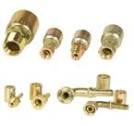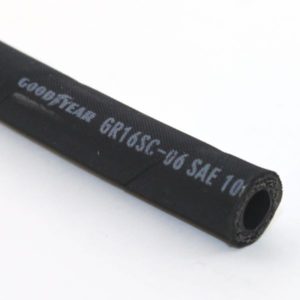Hose assemblies are installed on hydraulic systems through use of threaded, flanged or tube welded ends. Factors involved in the selection of the proper hydraulic hose end are:
Fluid Compatibility: Carbon steel is the most common metal used in the fabrication of hydraulic hose ends. Brass and stainless steel products are also available.
System Pressure Requirements: Will the hose end be subject to positive pressure (measure in Psi, Bar or kPa) or negative pressure (inch HG)? 
System and Environmental Temperatures: What will be the maximum temperature of the fluid running through the hose assembly? What is the temperature range that the exterior of the hose assembly will be subject to?
Installation Design: The following types of installation methods are available for hydraulic hose ends:
Crimp: Either one piece or two piece ends comprised of a hose stem and external ferrule. The end is connected to the hose by radially crimping or compressing the ferrule around the outside of the hose. Crimpers are available that are powered by electric hydraulic pumps, air over hydraulic pumps and hand pumps. This method can be used to fabricate all types of hydraulic hose assemblies and offers the widest range of connection types.
Swage: Similar to crimp style hose ends, swage ends are one piece in design. Instead of being radially crimped, a swaged end is driven into a die set and compressed from the bottom up. Swagers are generally less expensive than radial crimpers but are limited in size and speed. The connections types available with a swaged stem are limited.
Reusable: Comprised of a hose stem and outer socket, reusable hydraulic hose ends can be applied with hand tools and a vise. Connection types and sizes are limited.
Hose Size: Hydraulic hose ends are available for hose inside diameters that range from 1/8” through 3”. Inside diameters are denoted using dash sizes.
Typical Standard Sizes: Fleet Sizes:
Dash 2 (1/8”) Dash 4 (3/16”)
Dash 3 (3/16”) Dash 5 (1/4”)
Dash 5 (5/16”) Dash 8 (13/32”)
Dash 6 (3/8”) Dash 10 (1/2”)
Dash 8 (1/2”) Dash 12 (5/8”)
Dash 10 (5/8”) Dash 16 (7/8”)
Dash 12 (3/4”) Dash 20 (1-1/8”)
Dash 16 (1”) Dash 24 (1-3/8”)
Dash 20 (1-1/4”) Dash 32 (1-13/16”)
Dash 24 (1-1/2”)
Dash 32 (2”)
Dash 40 (2-1/2”)
Dash 48 (3”)
Corrosion Requirements: Hydraulic hose ends are most commonly made of heat treated carbon steel. High corrosion environments such as a paper mill or chemical plant may require usage of stainless steel hose ends. Brass hose ends are commonly used in truck fleet and marine applications.
Connection Type: Thread or connection options include:
JIC 37 Degree Flare Code 61 Flange
SAE 45 Degree Flare Code 62 Flange
SAE 45 Degree Inverted Flare Caterpillar Flange
NPTF (National Pipe Tapered) Komatsu Flange
NPSM (Female Pipe Swivel) British Standard Parallel Pipe
Standpipe British Standard Tapered Pipe
O-Ring Face Seal DIN 24 Degree Light
O-Ring Boss Straight Thread DIN 24 Degree Heavy
Japanese Industrial Standard DIN 60 Degree
For ease of routing various angles of bent tube elbow ends are available. To view Goodyear’s catalog featuring hydraulic hose fittings, click here.
Note & Tips
- Amazon Hose and Rubber is a master distributor for Goodyear Engineered Products and Eaton/Weatherhead.
- Hydraulic adapters and quick disconnect couplers are also available.
- Hydraulic hose assemblies are made to order.

Dear Sir / Madam,
I am seeking 1/4″ BSPP (male) brass hose ends to fit either 5/16″ or 1/4″ hose. These will be used to crimp onto low pressure scuba diving hose and then tested and certified before use in our commercial diving company.
If you are able to offer any information on the above it would be greatly appreciated.
Regards
Jason.